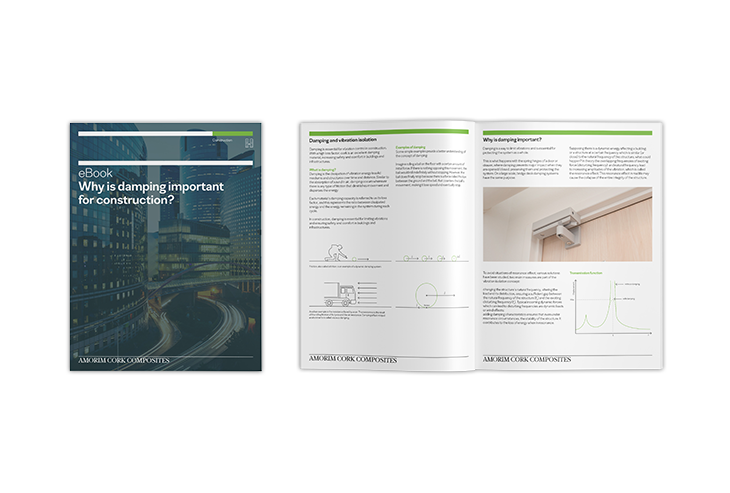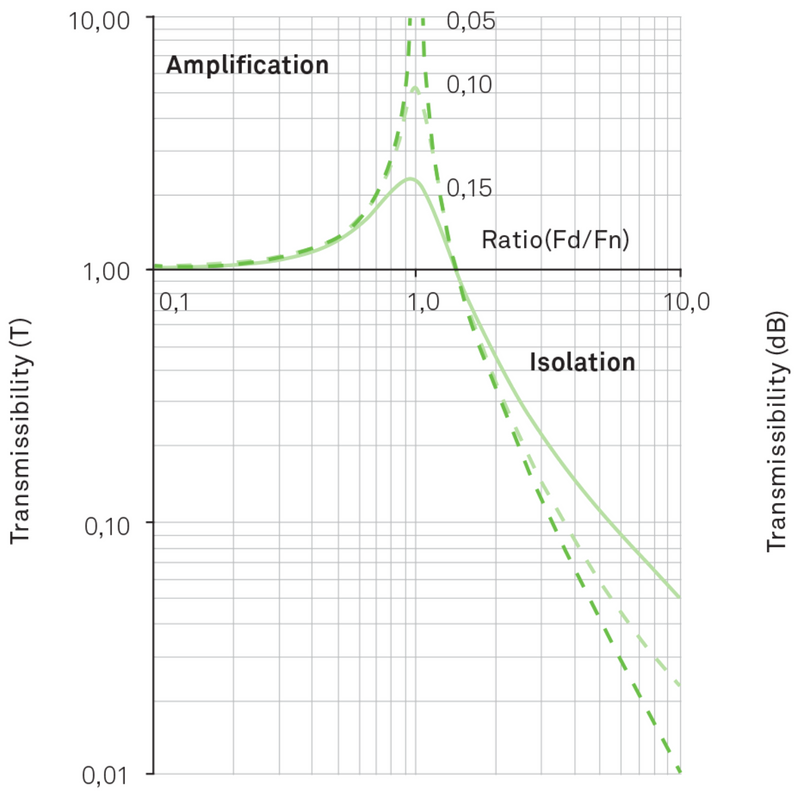Damping and vibration control
Damping is essential for vibration control in construction. With a high loss factor, cork is an excellent damping tool, boosting security and comfort in buildings and infrastructures.
What is damping?
Damping is the dissipation of vibratory energy in solid mediums and structures over time and distance. Similar to the absorption of sound in air, damping occurs whenever there is any type of friction that diminishes movement and disperses the energy.
Each material’s damping capacity is referred to as its loss factor, and this represents the ratio between dissipated energy and the energy remaining in the system during each cycle.
In construction, damping is essential for limiting vibrations and ensuring security and comfort in buildings and infrastructures.
Why is damping important?
Damping is a way to limit vibrations and is essential for protecting the system in which it operates.
This is what happens with door or drawer springs, where damping prevents blows when opened/closed, preserving them and protecting the system. While on a larger scale, bridge deck damping systems have the same purpose.
Supposing there is a dynamic sinusoidal load exciting a building structure or a structure with an exact frequency, what could happen? In theory, movements would become increasingly bigger and the structure would eventually collapse. This is what happened to the Tacoma Bridge in the United States, in 1940, a few months after its inauguration.

Construction
E-book Vibration Isolation Acousticork
Damping is a way to limit vibrations and is essential for protecting the system as a whole.
Transmissibility: mass, rigidity and damping
An insulation system’s performance is determined by its transmissibility, i.e. by the ratio between the energy introduced to the system and the energy leaving the system. Vibration control material is selected considering the placement of the system’s disrupting frequency in the insulation area. Additionally, the insulation system damping volume will determine the system’s peak transmissibility level (fn). As damping increases, the peak value decreases.
-
The dynamic response and the transmissibility of a structure are essentially determined by their mass and rigidity properties, responsible for the energy remaining in the system, and by the damping, which determines energy loss in the system.
Of these three characteristics, damping is the least understood and the most difficult to predict and measure. Mass and rigidity are easier to understand and measure as they can be determined using static measurements.
-
Many vibration problems can be addressed using a simple physical model, known as the spring-mass system. If the mass is disturbed from the equilibrium position by a brief external force, it will have a natural frequency of f0. The range of this vibration disappears over time based on the spring damping function, described as the mechanical loss factor ( ).
Damping is responsible and can be measured by:
• vibration range reduction in the resonance phase;
• temporal variation in free vibrations;
• spatial reduction of forced vibrations.
Cork as a damping material
Due to its closed, cellular structure, filled with air, cork has a higher loss factor than rubber, which is essential for damping and consequent energy dissipation. Our specific polymer formulations and the addition of cork, with its unique compressibility and recovery features, enhance the material’s high loss factor.

The Acousticork Vibration Isolation range from Amorim Cork Composites offers solutions with an excellent compromise between damping and insulation.
The Acousticork Vibration Isolation range from Amorim Cork Composites offers solutions with an excellent compromise between damping and insulation.
Do you want to know more about our vibration isolation solutions?
Acousticork range mechanical loss factor (π):
| Material |
Loss Factor (DIN 53513)* |
| Acousticork VC1001 |
0.15 |
| Acousticork VC1002 |
0.13 |
| Acousticork VC1003 |
0.16 |
| Acousticork VC1004 |
0.16 |
| Acousticork VC1005 |
0.10 |
| Acousticork VC1006 |
0.14 |
*Temperature, frequency and load dependent
Would you like to know more about this subject?
Let us know your details and we'll get back to you.






